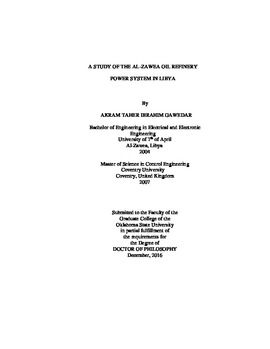| dc.contributor.advisor | Ramakumar, R. | |
| dc.contributor.author | Gawedar, Akram Taher Ibrahim | |
| dc.date.accessioned | 2018-06-25T13:38:20Z | |
| dc.date.available | 2018-06-25T13:38:20Z | |
| dc.date.issued | 2016-12 | |
| dc.identifier.uri | https://hdl.handle.net/11244/300239 | |
| dc.description.abstract | Libya is an oil exporting country located in the middle of the North Africa. Exporting oil is the major income resource for the economics of the country. Al-Zawea refinery is one of the oil refineries in Libya. It is the largest refinery in the region. The refinery is located on the Mediterranean coast. Electricity is the main enabler in the refinery to produce and export oil. The refinery experienced power fluctuations in the last few years due to its own power plant instability and frequency variants. This research discusses the aspects of upgrading the existing power system of the refinery by converting it from a traditional system to a smart system (Smart Grid) to overcome the technical power problem. Smart grid technology is very much in the forefront in the energy and power industry. Billions of dollars have been invested so far for smart grid implementation. The effective utilization of smart grid technology to achieve bi-directional power flow, integration of renewable energy sources, and improving the quality and reliability of power supply require suitable communication systems and sensors. Intelligent system requires sensing and switching technology to communicate with the electric grid. Integrating renewable energy resources to the system is a main feature of Smart Grid implementation. A portion of the power supply of the system will be derived from Wind Energy to feed the electricity into the refinery electric grid and ensure sufficient power for operation. Although, renewable energy application in Libya was started in the middle of the seventies, it has still not found its way into industry sector. This study employs earthier a wind speed analysis in the site (AL-Zawea City) using Raleigh pdf to model the wind speed which is the initial step to integrate wind with the existing grid. System with 25 buses has been used for simulation studies and implementation suggestions. Possible impacts of renewable (wind) energy system integration and its performance with the Al-Zawea refinery electric grid will be studied by load flow analysis using Newton Raphson method and Matlab software with PowerWorld. | |
| dc.format | application/pdf | |
| dc.language | en_US | |
| dc.rights | Copyright is held by the author who has granted the Oklahoma State University Library the non-exclusive right to share this material in its institutional repository. Contact Digital Library Services at lib-dls@okstate.edu or 405-744-9161 for the permission policy on the use, reproduction or distribution of this material. | |
| dc.title | Study of the Al-Zawea oil refinery power system in Libya | |
| dc.contributor.committeeMember | Cheng, Qi | |
| dc.contributor.committeeMember | Ekneligoda, Nishantha | |
| dc.contributor.committeeMember | Madihally, Sunda V. | |
| osu.filename | Gawedar_okstate_0664D_14871.pdf | |
| osu.accesstype | Open Access | |
| dc.type.genre | Dissertation | |
| dc.type.material | Text | |
| thesis.degree.discipline | Electrical Engineering | |
| thesis.degree.grantor | Oklahoma State University | |
